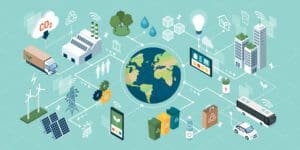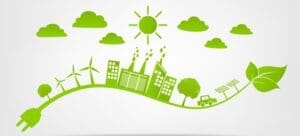 Supply chain sustainability can mean a lot of things to a lot of people. As I have written about before, supply chain sustainability, or the notion of going green, is a hot topic as companies and countries look at their overall carbon footprint and look for ways to be more environmentally friendly. A few ways companies can begin to offset their carbon footprint is to take a deeper look at product packaging, energy efficiency, alternative fuels, route optimization, and returns and recycling programs. However, supply sustainability goes well beyond these initiatives.
Supply chain sustainability can mean a lot of things to a lot of people. As I have written about before, supply chain sustainability, or the notion of going green, is a hot topic as companies and countries look at their overall carbon footprint and look for ways to be more environmentally friendly. A few ways companies can begin to offset their carbon footprint is to take a deeper look at product packaging, energy efficiency, alternative fuels, route optimization, and returns and recycling programs. However, supply sustainability goes well beyond these initiatives.
I’ve spoken to many supply chain leaders over the last few years and sustainability has consistently come up as a top priority. Looking at sustainability from a supply chain standpoint, the beauty is that sustainability ultimately results in savings. For supply chains, sustainability is symbiotic with profitability. It can take miles out of the transportation journey, air from a carton or box, or reduce trips to a specific neighborhood or house. This means money can be saved. At the same time, these “savings” can reduce greenhouse gas emissions and overall carbon footprints.
That being said, aside from the money-saving aspects of supply chain efficiencies, there are a growing number of companies that are putting the environment first and looking at the Sustainable Development Goals (SDGs) put forth by the UN as well as science-based targets for supply chain sustainability. Here is breakdown of what these goals mean and how companies can implement these initiatives for a more sustainable supply chain.
UN Sustainable Development Goals
The SDGs developed by the UN are a collection of 17 interlinked global goals designed to be a “blueprint to achieve a better and more sustainable future for all”. The SDGs were set up in 2015 by the United Nations General Assembly and are intended to be achieved by the year 2030 and are included in a UN Resolution called the 2030 Agenda. The SDGs were developed in the Post-2015 Development Agenda as the future global development framework to succeed the Millennium Development Goals which were ended in 2015.
The 17 SDGs are: (1) No Poverty, (2) Zero Hunger, (3) Good Health and Well-being, (4) Quality Education, (5) Gender Equality, (6) Clean Water and Sanitation, (7) Affordable and Clean Energy, (8) Decent Work and Economic Growth, (9) Industry, Innovation and Infrastructure, (10) Reducing Inequality, (11) Sustainable Cities and Communities, (12) Responsible Consumption and Production, (13) Climate Action, (14) Life Below Water, (15) Life On Land, (16) Peace, Justice, and Strong Institutions, (17) Partnerships for the Goals.
Each goal typically has 8 – 12 targets, and each target has between one and four indicators used to measure progress toward reaching the targets. The targets are either “outcome” targets or “means of implementation” targets. Most companies do not look to tackle all 17 SDGs; instead, they focus their efforts on a few targets initially.
For example, Mars has been purposeful on where to focus their efforts. The company is prioritizing SDG 1: no poverty; SDG 17: partnerships for the goals; and SDG 13: climate action. Climate action is incredibly important for Mars and its supply chain partners. To that end, Mars started with a commitment to 100 percent renewable energy a number of years ago and is making steady progress. The company has established long-term power purchase agreements at the country level. As a result, Mars has been able to procure renewable electricity to cover the entire business in those specific countries. The next part is to drive progress toward a science-based target that goes across value chain. Mars is working with top suppliers to take action similar to what they have done with renewable energy and launched a “Pledge for the Planet” a few years ago, asking suppliers to join them in a pledge for sustainability.
Science-Based Targets
However, a common critique of the SDGs has been that they are weak on environmental sustainability. This is where the Science Based Targets (SBTs) come into play. Science-based targets provide a clearly defined pathway for companies to reduce greenhouse gas (GHG) emissions, helping prevent the worst impacts of climate change and future-proof business growth. Targets are considered ‘science-based’ if they are in line with what the latest climate science deems necessary to meet the goals of the Paris Agreement – limiting global warming to well-below 2°C above pre-industrial levels and pursuing efforts to limit warming to 1.5°C.
Last year, The COP26 global climate change summit took place in Glasgow, where 190 world leaders and thousands of government officials, business representatives, and nonprofit groups made commitments to address climate change threats. While other industries such as oil and gas, coal, cement, steel, aluminum, and automobiles and transportation play a larger role in climate change, retail leaders have stepped up to meet climate change goals. More than three dozen of the largest retailers in the US have set or committed to setting Science Based Targets that provide a clear route to reduce their greenhouse gas emissions.
The SBT process requires businesses to quantify their current emissions, set specific meaningful carbon reduction targets with measurable interim goals, reduce greenhouse gas emissions, report on their progress, and help others along the way. Retailers face a significant hurdle here though, as more than 90 percent of the emissions associated with their businesses occur outside of their direct control as part of their “scope 3” emissions. An example of a company looking to adhere to SBTs is SanMar, the largest wholesaler of apparel into the corporate identity, promotional product, and ad specialty space in the United States.
SanMar is committed to reducing its global greenhouse gas emissions in line with achieving global warming targets of less than 1.5 degrees Celsius. This means the company will need to use much more sustainable fibers and use renewable energy sources. While the company is not sure how it will achieve the goal, it knows that it has to aim high. SanMar’s most successful sustainable product is the re-tee. The re-tee takes recycled cotton that is gathered from cutting scraps, broken down, spun into yarn, and turned into new shirts. The shirt is the color of the scraps, so it is more sustainable since it is never dyed.
Final Thoughts on Supply Chain Sustainability
Supply chain sustainability is incredibly important to the future of our planet. Supply chains are built with a higher purpose, as they exist to serve humanity. And while it can be a money-saving opportunity from a transportation standpoint, there are more important issues at hand. Ideally, the aforementioned SDGs and SBTs will co-exist with a clear vision to reduce greenhouse emissions and make a better future for us all. Thankfully there are thousands of companies that are investing in the future and making supply chain sustainability a priority. We can only hope that it works.
















 Supply chain sustainability is a higher priority than ever. In MIT’s
Supply chain sustainability is a higher priority than ever. In MIT’s  Polly Mitchell-Guthrie is the VP of Industry Outreach and Thought Leadership at
Polly Mitchell-Guthrie is the VP of Industry Outreach and Thought Leadership at  The global supply chain is routinely beset by challenges, both large and small, but the past couple of years have delivered a string of significant logistics disruptions that have threatened to upend the tightly choreographed dance of global freight transportation. The coronavirus pandemic is the most obvious of these hurdles, but everything from the threat of tariffs to the temporary blockage of the Suez Canal (and even the ongoing closure of the I-40 bridge in Memphis) could have had lasting ramifications for global commerce.
The global supply chain is routinely beset by challenges, both large and small, but the past couple of years have delivered a string of significant logistics disruptions that have threatened to upend the tightly choreographed dance of global freight transportation. The coronavirus pandemic is the most obvious of these hurdles, but everything from the threat of tariffs to the temporary blockage of the Suez Canal (and even the ongoing closure of the I-40 bridge in Memphis) could have had lasting ramifications for global commerce.




